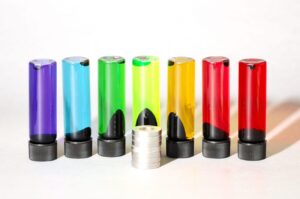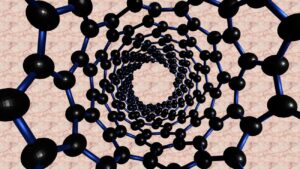Zeolite.
It’s an aluminosilicate mineral by definition. Silico-aluminate. Powdered aluminum.
Toxic.
Ironically, in the natural health world, zeolite is advertised and promoted as a metal detoxifier; something that binds to and removes metal toxins from the body. Zeolites are promoted in industry to minimize environmental issues linked to landfill disposal leakage.
Zeolites constituent [SiO4]4 −and [AlO4]5 . According to this 2005 article, they share all corners to create a three-dimensional framework structure carrying a negative charge.
Nearly 100 different frameworks have been crystallographically defined for zeolites, and related structures, each one having a unique molecular architecture. The internal dimensions of their channels and cavities are close to molecular dimensions and this has led to their employment as ‘molecular sieves’ and catalysts.
Some zeolite structures, high in aluminum, cannot be used in living systems (in vivo) because they are not stable in acids. But how do zeolite manufacturers assure the right form is used in human health applications?
Are zeolites safe in the body?
Waste Incineration Fly Ash
Whether recycled from volcanic ash, or synthesized from incineration fly ash, both sources of zeolite are synthesized from toxic ash clouds, i.e. waste.
Normally, waste is incinerated and sent to landfills for disposal. However, with the problems of available landfill space decreasing, hazardous substances leaching out of landfills, not to mention the cost of solidification, or burial of hazardous waste, what can be done?
From the 2021 Journal of Environmental Chemical Engineering:
The ash or residue materials containing rich silica and alumina are dissolved in the alkaline solution to form the aluminosilicate as the precursors of zeolite, after aging for a period of time, the aluminosilicate solution is put into an autoclave to conduct hydrothermal reactions at a specific temperature and pressure and the crystalline zeolite is formed gradually.
The recycling of hazardous waste to become a “healthy” additive is nothing new.
Fluoride in The Water
 The same has been done with toxic waste byproducts from phosphate fertilizer production; hydrfluoroosilicic acid (HFSA), also known as fluoride.
The same has been done with toxic waste byproducts from phosphate fertilizer production; hydrfluoroosilicic acid (HFSA), also known as fluoride.
The CDC and U.S. Environmental Protection Agency (U.S. EPA) allow HSFA to be added as “fluoride” to municipal drinking water. For more than 80 years, HFSA has been deemed by “experts” as “safe” in preventing tooth decay. Even though there is plenty of proof that HFSA causes dental fluorosis.
These agencies know that, if buried, poisonous arsenic leaches into groundwater worldwide. Thus, the problem was transferred to public water supplies.
If a fluoride level of 0.7 mg/L, the “optimal” level used in U.S. and Canadian drinking water fluoridation projects, can create neurodevelopmental harm to the fetus, bottle-fed infant, and child, then what does it do to an adult who has been drinking tap water over the course of a lifetime?
Fluoride increases the body’s ability to absorb aluminum. And where does the aluminum go? The bones. The brain. What metal shows up in the brains of Alzheimer’s victims? Autism? Multiple Sclerosis? Aluminum.
The studies show a lowered I.Q. in any population that drinks fluoridated water. Within phosphate fertilizer waste (HFSA) is arsenic and lead, among other toxins. This leads to numerous forms of cancer in any population that drinks municipal fluoridated, water.
Even the American Dental Association (ADA) says fluoride is safe in community water fluoridation programs. Yet, the ADA also calls fluoride “a mineral that is found in all natural water sources and is the ionic form of the trace element fluorine, which is commonly found in the environment. Why the contradictions?
An April 22, 2013 Earth Day petition from a U.S. University, delivered to the U.S. EPA Administrator appealed to reason regarding HFSA’s carcinogenicity, but also the costs saved by eliminating fluoridation of the public water supply (of between 1 and 6 billion annually). However, no amount of information, legal wrangling, or courtroom trials, have ended the addition of industrial toxic waste products to the water supply. The latest court case sits in California without a ruling. Will EPA ever be forced to ban toxins in tap water?
Are fluoride drinkers more likely to disregard the dangers of nanotechnology?
Nanotechnology can be defined as “the art and science of manipulating matter at the nanoscale (down to 1/100,000 the width of a human hair) to create new and unique materials and products…seemingly ordinary materials may behave completely differently than in their larger bulk or macro form.
Due to their small size, nanoparticles can cross biological membranes, cells, tissues and organs more readily than larger particles. Once in the blood stream, nanomaterials can circulate throughout the body and can lodge in organs and tissues including the brain, liver, heart, kidneys, spleen, bone marrow and nervous system. Once inside cells, they may interfere with normal cellular function, cause oxidative damage and even cell death.
Ironically, calcium nano-fertilizer is being used to counter the effects of oxidative stress from fluoride uptake in rice!
Zeolite NanoTechnology
Zeolite is used in nanotechnology, specifically in the nanotech delivery of medications, as biosensors. Biosensing is the basis of Smart Delivery, Monitoring, Surveillance, and Healthcare. Nano-doped zeolites are becoming a common solution for nanotechnology.
 More broadly, zeolites are important to the industries of Artificial Intelligence, A.I. Their nano-crystalline structure is useful to biomedical applications, not only as biosensors, but also as: Vaccine adjuvants, Antimicrobial agents, Drug and Gen delivery, Hemodyalisis, external applications, Diabetes Mellitus, Detoxicants, Bone formation, Anti-diarrheal agents, Anti-tumor adjuvants, and Enzyme mimetics.
More broadly, zeolites are important to the industries of Artificial Intelligence, A.I. Their nano-crystalline structure is useful to biomedical applications, not only as biosensors, but also as: Vaccine adjuvants, Antimicrobial agents, Drug and Gen delivery, Hemodyalisis, external applications, Diabetes Mellitus, Detoxicants, Bone formation, Anti-diarrheal agents, Anti-tumor adjuvants, and Enzyme mimetics.
Today, depending on the brand or product, zeolites bind toxins for removal, while also building nano-systems for medical interventions.
Zeolites were used as part of the CoV-BAN, Internet of Things (IoT) Network, as a real time health monitoring system. A biosensor map of the world can identify people in real-time, whether you are pharmaceutical-friendly or “alternative.”
Before applying zeolite to your routine, or listening to “experts” who promote it for their own profit, do your own research. Even with a lowered I.Q. from drinking fluoridated water, anyone can protect themselves by asking questions and checking the source.
These days, toxins are not only in the water, but also in fast foods, and in the air we breathe. People, who turn to supplements for help, need to ask if any new-and-improved product is safe or shaky?
Related articles:








Almost a decade ago, a friend N.D., suggested never take Alumium/Zeolight – Nor- Anything Nanoparticle! Monkey Pox ??? “Towards a Worldwide Monkeypox Pandemic? Big Money Behind “Fake Science”
When the Lie Becomes the Truth
MICHEL CHOSSUDOVSKY https://michelchossudovsky.substack.com/p/worldwide-monkeypox-pandemic-big-money-fake-sci?utm_source=post-email-title&publication_id=1910355&post_id=147885406&utm_campaign=email-post-title&isFreemail=true&r=oh0ob&triedRedirect=true&utm_medium=email
That was an astute ND! Now everything, including dental anesthetics are nano!
So, there is NO form of zeolite what is safe?
I have a filter which contains zeolite, and there is an MD promoting it – but he is adamantly against the allopathic medicine!!
I will send the article to him.
Would you, meanwhile, reply to my first question?
Thank you.
Lawrence
As I am not the maker or seller of your product, you’ll need to go to the source for your answer. You might also ask whether your product is sourced from volcanic ash or incinerator ash? What is the process to make it zeolite? What does the metals testing show? How does the body utilize it? Are the kidneys affected as these metals go through the body?
Just some questions that come to the surface for me….
The time of trusting other “opinions,” whether MD or ND, or ‘Consumer Reports’ is over. I hope that is clear in my blogs. The main point is to discern and ask the questions of yourself.
Each of us needs to do our own investigation if we purchase or consume anything. We need to take responsibility for our bodies and our choices.
You need to know the source so you can make an informed decision.
You do not need me or anyone else to tell you to consume or not consume.
We have our own thinking brains for that.
Your body, your choice.
The information I present includes a note on contradictions.
In many of my blogs, I report contradictions and inconsistencies. Why?
To make you question what you are doing.
I do not have the power to tell you what to do. Nor should I seek it.
You are here to make your own choices.
The point of this blog is to be discerning.
You misunderstood my question.
The point was: Do YOU know a safe form, since you display your “knowledge” here? Do you have THAT knowledge?
Don’t give lessons about how to discern things.
There is nothing to discern in absence of information, and you seem to pride yourself on having such; otherwise, why ramble over the internet with your blog?
And regarding mpox:
Do you have the knowledge that NO VIRUS has ever been shown to exist??????????????????
IF you do, why don’t you say it?
Obviously, you don’t.
Nomore,
I did not misunderstand your question. I do not take zeolite and do not know the brand you take. So for answers to your question, go directly to the source of your product. Do you not make choices based on the investigations you do? Each of us does our own investigation as we are each unique humans.
I DO NOT know a safe form of zeolite since all zeolite is processed to create the product from a toxic substance. I would utilize other products straight from NATURE. That investigation is for you to do. I am not your naturopath, and therefore, cannot give you advice unless you become a client.
I stand by my words. Each of us are here to take responsibility for our health, and our freedoms. We are not handed them on a platter.
I wish you well in your study for knowledge. We each have the capacity to think for ourselves, so go forth and think.
And “Nomore” questions that you can answer for yourself. DO the research. Know the risks. Don’t be duped.
For related questions, seek out my other blogs. Some of your questions are discussed there.
You sure don’t need my permission to take any supplement.
Thomas S. Cowan, MD, and Sally Fallon Morell’s book “The Contagion Myth: Why Viruses (including “Coronavirus”) Are Not the Cause of Disease. C 2020.
This is my favorite new book. You can go back in time to the time of Pasteur and Beauchamp, and realize that Germ theory was financially promoted by Rockefeller big money who systematically used it to expel natural medicine that focused on healing the cause of disease and to replace it with allopathic pharmaceuticals that became synthetic and only chased symptoms not cause for intentional and deliberately planned financial gain and control over the sick bodies.
There was a brilliant HIV AIDS professor at Harvard 2 decades ago who also came to the same conclusion. He observed that the human exosome was one and the same with the virus, which is impossible if the virus in the non-self agent that supposedly “infects” and the exosome is clearly a part of self that results as the body heals. This is another pathway that proved in a different way than Cowan and Fallon that what is being called a “virus” is non-infective and a healing phenomenon that when it is attempted to be isolated to be proven infectious in Koch’s postulates (the science that must be used to prove any infectious agent exists) it was found to be exactly the same thing that was called an exosome cast off from the body during healing.
The reason that so many people think that viruses exist is because they believe and take at face value the unverified claims of others seeking to make money and huge profits off of all these people that they misled and fooled for years. Nobody has successfully ever isolated any “infectious virus” to use it by the rules of Koch’s postulates which must prove that the isolated “virus” can repliicate the infection in other humans, but it is outrageous and unacceptable scientifically that these “scientists” that talk about “infectious viruses” have NEVER isolated and replicated and performed the scientific analyses required by Koch’s Postulates. That defines such “scientists” like Dr. Fauci and others who claimed that COVID was caused by COV2 virus to not be actual scientists using the rigorous rules and rigorous definitions that have been worked out with long-term peer review of consensus of observational results and analysis, which must seriously consider even one contradictory analysis and interpretation with rigor until peer review comes to consensus of the scientific facts surrounding the observations. Dr. Fauci is not a scientist, and no one man contains approval of what is science, as that claim in and of itself is a violation of the rules and standards of rigorous scientific debate and analysis. The science is not allowed to name-call and cast dispersions upon character and personality which are distractions away from the science, and illegitimate non-sense = non-science.
Healers should be paid based on success, not failures.
If you’ve been reading my work over the last 14+ years you will see I agree with most of what you say.
These articles answer your questions:
No Such Thing As a Safe Vaccine – https://www.natureofhealing.org/reclaiming-vaccine-narrative-no-thing-safe-vaccine-2/
The Religion of Vaccine Science – https://www.natureofhealing.org/the-religion-of-vaccine-science/
Vaccine Debate: Ruse to Eliminate Freedom – https://www.natureofhealing.org/vaccine-debate-ruse-eliminate-freedom/
Vaccines: The Death of Natural Immunity – https://www.natureofhealing.org/vaccines-the-death-of-natural-immunity/
Informed Consent: The Elephant In The Room – https://www.natureofhealing.org/the-power-of-consent/
Great article. I avoid aluminum like the plague…
Good for you! That is getting harder and harder to do! Especially as we are breathing it in the air daily!
See this on solar geoengineering…. https://www.bmj.com/content/377/bmj.o1150/rr-1